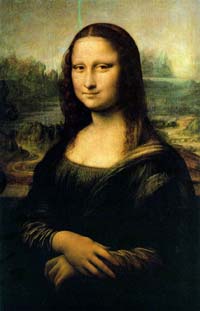|
When Monica Lewinsky appeared
as Mona Lisa on the cover of The New Yorker in
February 1999, we witnessed a deployment of Leonardo da
Vinci’s painting for social satire. It is just one
memorable example of the many ways that the Mona Lisa
has been appropriated over the years by advertisers,
merchandisers and artists. In Becoming Mona Lisa: The
Making of a Global Icon (Harcourt, 2001), historian
Donald Sassoon traces the Mona Lisa’s rise
to stardom—from its creation in 1503 to its stature
in the twentieth century as a global icon of popular culture.
In da Vinci’s lifetime,
the Mona Lisa was considered a masterpiece, receiving
praise from Vasari and inspiring Raphael. Subsequent generations
of European artists and writers were also impressed by
the painting. But it wasn’t until the second half
of the nineteenth century—when the new art critics
began to shape public opinion and mass media became possible—that
the Mona Lisa became famous. With the proliferation
of this famous portrait on t-shirts, coffee mugs, mouse
pads and other trinkets in the late twentieth century,
Mona Lisa has indeed become ubiquitous.
 |
Becoming Mona Lisa
is a fascinating account of how the Mona Lisa became
what it is today. Based on extensive research, Sassoon
reveals how the painting was created, who the subject
was, why it achieved unrivaled status in the art world
and the role that museums, art critics, mass media and
commerce played in the painting’s ascending cultural
importance. However, Mona Lisa took some twists
and turns on her way to becoming a pop icon, as the following
excerpt from Becoming Mona Lisa shows:
Iconoclastic attacks
on the Mona Lisa have been ‘one of the surest
(if most perverse) tributes that other artists have paid
the painting.’ The same can be said of less metaphorical
forms of iconoclasm, such as vanDalism.
On 30 December 1956
Hugo Unzaga Villegas, a forty-two-year-old Bolivian, threw
a stone at the Mona Lisa, slightly damaging its
elbow. The following day, the story was covered by almost
every newspaper in the world, from the East Anglian
Daily Times to the Royal Gazette of Bermuda
and the Polish Zycie Warszawy. The newspaper cuttings
fill three large boxes carefully preserved in the Louvre
documentation centre. A psychiatric report on Villegas
by Dr. Gouriou (14 January 1957) found that the man was
insane, heard strange voices, and had intended to murder
the Argentinean dictator Juan Perón, but went instead
for the less well protected Mona Lisa. Though the
event was certainly newsworthy, it could not produce on
its own more than one or two paragraphs of copy, at least
on the first day. But newspapers fill the available space
with relevant items from their file of clippings and with
quotes obtained from accessible and serviceable experts.
Anyone could come up
with a view of the attack, even years later. In 1963 Salvador
Dali provided his own ‘Freudian’ interpretation:
imagine, he wrote, a naïve Bolivian visiting the
Louvre. He perceives the museum as a whorehouse full of
naked, shameless statues—these Rubenses, this naked
flesh. He notices, hanging on a wall, the portrait of
his own mother. What is she doing in a place like this?
She too must be a whore. What’s more, she is smiling
ambiguously at him. He has two options: the first is to
run away with the portrait and hide it, piously, where
it cannot be found; the second is to assault it. Dali
has a point. It is difficult to imagine an attack on Raphael’s
Baldissare Castiglione (though he could look like
someone’s father). Usually, men who attack pictures
attack those representing women.
 |
Unzaga Villegas’s
stone ensured that selected aspects of the Mona Lisa
story would be told all over again; in particular, the
story of the theft, along with a couple of lines from
some well-known cultural sources—usually Freud, since
by the 1950s Gautier and Pater were no longer household
names. Then one could dwell on any of the three canonical
mysteries: Why is the smile enigmatic? Who was the model?
Is the Louvre Mona Lisa authentic?
Nothing could be simpler
than to get a few experts to come up with apparently controversial
comments on any of the above. Mona Lisa stories
are among the easiest for the press to cover. Name recognition
is very high among readers. The few who had not heard
of it could be authoritatively informed that it was the
best-known picture in the world, painted by a universal
genius. The controversies surrounding it were of importance
only to specialists, yet were of interest even to those
who, quite rightly, did not really care who was the model.
Stories about the Mona Lisa could be classed as
‘cultural’ while being of interest to both ends
of the market.
As a marketing instrument
working on behalf of the Mona Lisa, Hugo Unzaga
Villegas’s blow had an effect comparable to Marcel
Duchamp’s moustaches, and produced even greater coverage.
Besides, Lisa’s ‘high culture’ association
with Leonardo continued to bear fruit. Throughout the
twentieth century the reputation of Leonardo had grown
exponentially—largely because of its scientific connection.
He was the kind of scientist everyone felt familiar with,
even without knowing what it was he had discovered or
invented. The four hundredth anniversary of his death
(1919) had been a relatively muted affair, but the five
hundredth anniversary of his birth (1952) was widely celebrated.
By then Leonardo had ‘won’ the popularity contest
against his traditional rivals Raphael and Michelangelo.
The evidence is all around us, in the imperceptible but
systematic, and often unwitting, promotion of Leonardo’s
image. Neither Raphael nor Michelangelo, for instance,
benefits from a pre-installed screen-saver on Microsoft
Windows 98 software. ‘Leonardo’, ‘Raphael’
and ‘Michaelangelo’ (sic) as well as ‘Donatello’
were the names given in 1984 by Kevin Eastman and Peter
Lairdin (both had studied art history at university) to
their enormously successful Teenage Mutant Ninja Turtles,
a comic-book strip which led to toys, games and a television
animation series. The leader of the Turtles was, of course,
Leonardo.
Raphael in particular
has suffered from his failure to produce a strikingly
popular piece of work such as Michelangelo’s David.
Raphael’s life has never been turned into a best-selling
book, as Michelangelo’s was in Irving Stone’s
The Agony and the Ecstasy (1961), later adapted
into a successful film starring Charlton Heston (1963).
In the nineteenth century
Lisa travelled on the back of the better-known Leonardo,
but in the twentieth she became bigger than her creator,
particularly in the mass market, where, as all advertisers
know, the real money is made. In 1934 Cole Porter wrote
the song ‘You’re the Top’ for his famous
show Anything Goes, in which the Mona Lisa smile
was—inevitably—included in the list of items
that are ‘the top’:
… You’re
the Nile;
You’re the Tower of Pisa;
You’re the smile
on the Mona Lisa…
Ella Fitzgerald has sung
it (beautifully), and so have Fats Waller, Dionne Warwick,
Barbra Streisand and many others. The idea that Mona
Lisa was ‘the top’ became a matter of course,
even in chess: The grand master Eduard Gufeld called his
greatest triumph his ‘Gioconda game.’
An even greater hit
than ‘You’re the Top’ (in which Lisa shared
the honours with other ‘tops’) was the song
‘Mona Lisa,’ by Jay Livingston and Ray Evans.
Nat ‘King’ Cole made it famous, singing it in
the film Captain Carey USA (1950), for which it
gained the Academy Award for best song. Cole’s wife
Maria had objected to his recording the song, feeling
than an ‘offbeat thing about an old painting wouldn’t
go.’ Nat insisted, and was proved right: ‘Mona
Lisa’ resolved, at a stroke, his financial problems.
It hit the number one spot on the US charts in July 1950,
and became the biggest-selling record of the year. Five
other singers, less well-known than Cole, also made it
into 1950’s top three hundred by singing ‘Mona
Lisa’: Don Cherry (No. 53), Charlie Spivak (198),
Harry James (192), Ralph Flanagan (243) and Dennis Day
(249). The song has since been recorded by Pat Boone,
Bing Crosby, Marlene Dietrich, Elvis Presley, Paul Anka,
Conway Twitty, Donny Osmond, Tom Jones, Julio Iglesias,
Elglebert Humperdinck and many others. Jazz versions have
included those by Sonny Rollins and, in Japan, Masabumi
Kibuchi. It has been included in a French compilation
of songs about women called ‘de l’eternal
féminin,’ sung by Tino Rossi, whose distinctive
rolling ‘r’, Mediterranean intonation and Italianate
tenor voice were still fashionable in France in the 1950s.
But Nat King Cole’s remained the classic version.
Almost forty years after his untimely death in 1965, anyone
tuning to an ‘easy listening’ radio station
is still highly likely to hear it.
Mona Lisa, Mona
Lisa, men have named you.
You’re so like the lady with the mystic smile.
Is it only ‘cause you’re lonely they have blamed
you?
For that Mona Lisa strangeness in your smile?
Do you smile to tempt a lover, Mona Lisa?
Or is this your way to hide a broken heart?
Many dreams have been brought to your doorstep
They just lie there and they die there.
Are you warm, are you real, Mona Lisa?
Or
just a cold and lonely, lovely work of art?
*Donald
Sassoon is professor of history at Queen Mary College
of the University of London. He is the author of Contemporary
Italy: Economy, Society and Politics Since 1945 and
One Hundred Years of Socialism and is a frequent
contributor to major British and European publications.
|